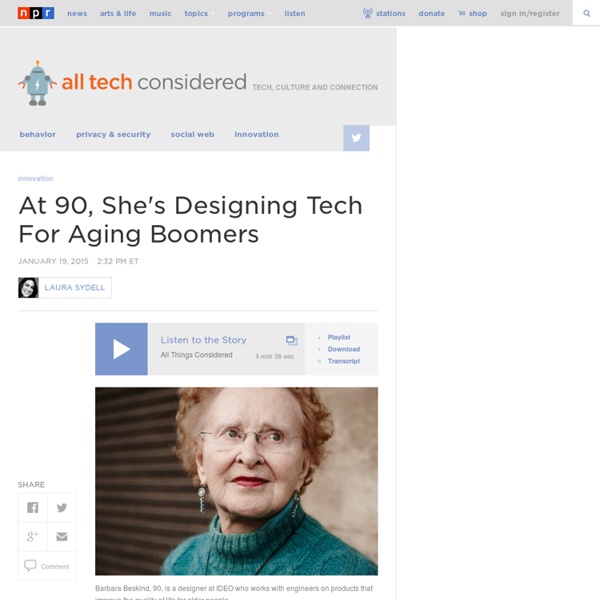At 90, She's Designing Tech For Aging Boomers : All Tech Considered

The Phone For Disabled People Lets You Surf Facebook With Only Your Face
Working on UI and UX for smartphones is difficult enough. It becomes even more difficult when your target population is disabled. But a growing number of companies, ranging from small startups to tech giants, are busy at work creating smartphone interfaces for quadriplegics and paraplegics. To serve users, designers have to embrace face tracking, eye tracking, voice controls, and some no-brainer design approaches. For users who cannot move their own wheelchairs or groom themselves unassisted, being able to operate a phone grants a considerable amount of autonomy. Giora Livne, an engineer who became a quadriplegic after sustaining injuries in a fall, says being able to operate a smartphone independently changed his life. His company, Israel-based Sesame Enable, makes adaptive technology for handless operation of smartphones. The video below shows Candy Crush Saga being played via Sesame. The Rise Of The Accessible Phone Hawking says ACAT has doubled his typing speed.
What I Learned From Building An App For Low-Income Americans
I was lost in the Bronx. It was my first week as a Significance Labs Fellow, where my job was to create a tech product for some of the American households who earn less than $25,000 a year. In 2013, 45.3 million Americans lived at or below the poverty line, which for a family of four is $23,834. Another fellow and I spent an hour on the subway from Brooklyn to do a user interview. To some extent technology has failed low-income Americans too. It’s The Scarcity, Stupid Our first week was spent in some of NYC’s poorest neighborhoods interviewing all kinds of people. The product eventually built by my team was for housecleaners. Every person we met had an intensely individual story, but common themes emerged. It also became clear that inequality isn’t purely about income. Living on a low income translates into other forms of scarcity: of power, information, respect, opportunity, time, health, security, and even of sleep. Your Users Won’t Trust You I often didn’t feel good.
Designing a mobile interface for older people
Not so “smart” phones Most phones currently on the market have a touch screen. The touch-based interface can be confusing for many people. While fonts can be enlarged on some phones, this does not solve all potential problems. We have performed a research to discover how older people use their phones and have identified their capabilities and limitations, introduced key design recommendations and as a result, have created a new simplified mobile interface. Our granny doesn’t feel old The first idea came about from talking to our granny. We even bought her a simple senior-oriented phone. Android launcher as a solution We investigated a number of possible solutions. Most of the above alternatives do not provide a large keyboard. What do older people really want? We wanted to identify the best phone interface design possible. We interviewed five people above the age of 60. Impairments of older people Some individual abilities decline with age. Technology yes, but with a real benefit KoalaPhone
Designing For The Elderly: Ways Older People Use Digital Technology Differently
If you work in the tech industry, it’s easy to forget that older people exist. Most tech workers are really young1, so it’s easy to see why most technology is designed for young people. But consider this: By 2030, around 19% of people in the US will be over 652. Doesn’t sound like a lot? Well it happens to be about the same number of people in the US who own an iPhone today. Which of these two groups do you think Silicon Valley spends more time thinking about? This seems unfortunate when you consider all of the things technology has to offer older people. CNA – Speaking Exchange (watch the video on YoutTube4) While the ageing process is different for everyone, we all go through some fundamental changes. But ageing makes some things harder as well, and one of those things is using technology. (How old is old? Vision And Hearing From the age of about 40, the lens of the eye begins to harden, causing a condition called “presbyopia.” Key lessons: Motor Control Device Use Relationships Life Stage
Related:
Related:



